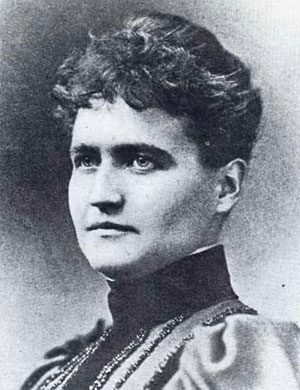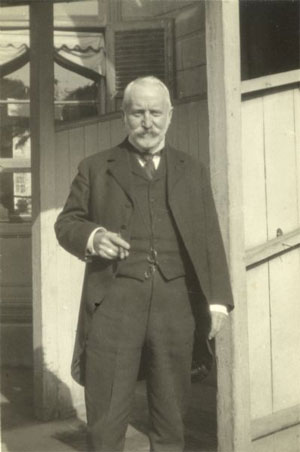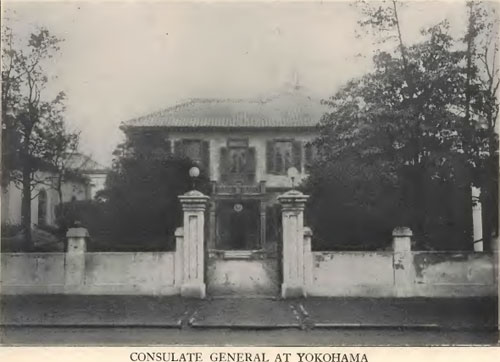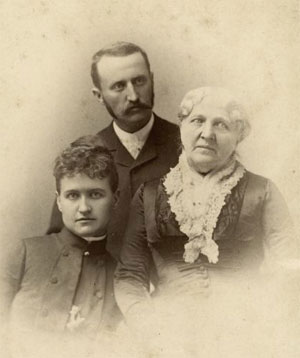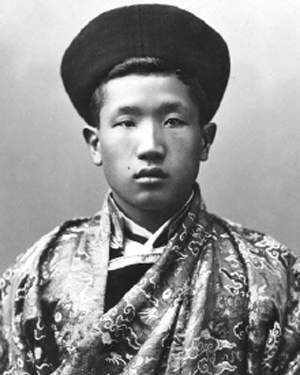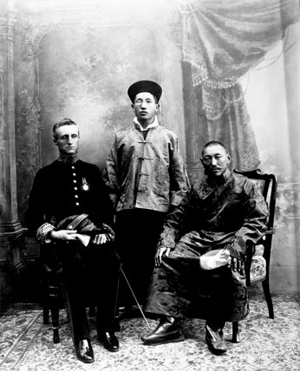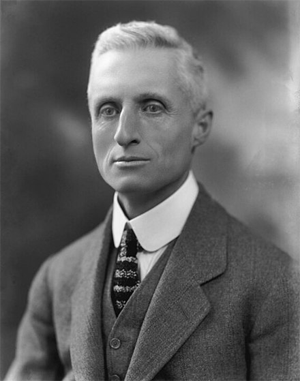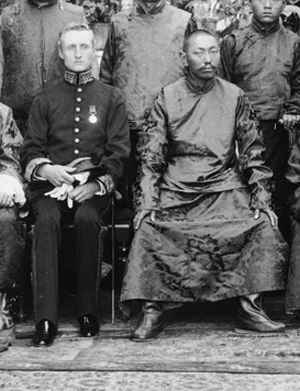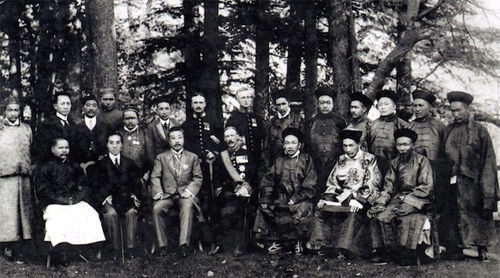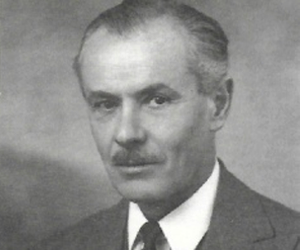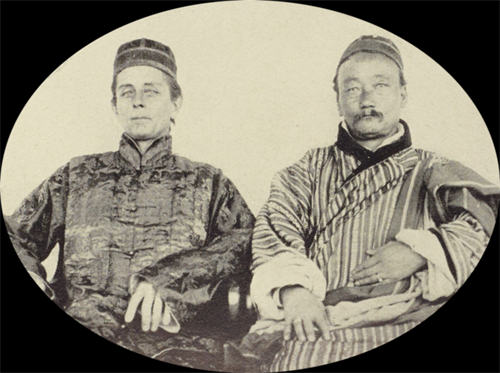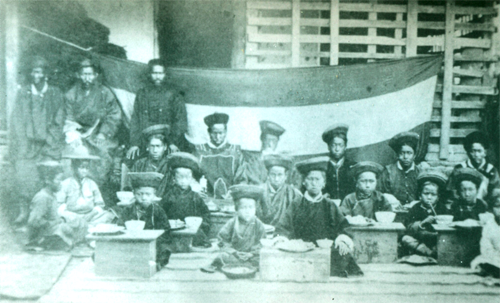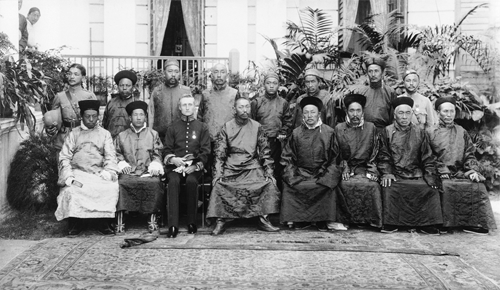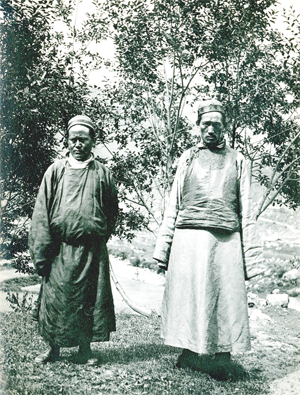Part 2 of 2
Ghum monastery: Dictionaries in a contact zoneThe Ghum monastery was founded in 1875 by Llama [sic] Sherabgyatsa, one of the Yellow-sect Geylukpa [sic], and was intended primarily as a place for political meetings more than as a monastery. It receives a grant of Rs. 60/- per mensem from the Government, is managed by a secretary and a committee, and has some fifty monks in residence.
— E. C. Dozey[70]
By the time Englishman Eric Collin Dozey, a long-time Darjeeling resident, journalist and author, published his tourist guide to Darjeeling and Sikkim in 1917, it was already an open secret that Ghum or Ghoom Monastery (figure 5) was a meeting place for many of those with an interest in Tibet.
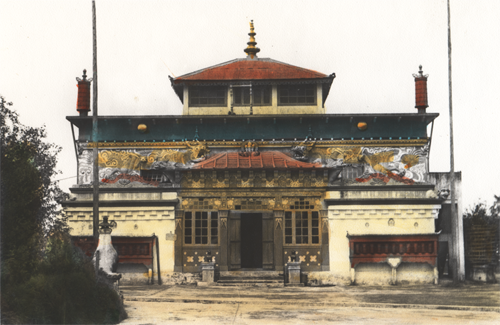 Fig. 5: Tinted postcard of Ghum Monastery, photograph taken after its restoration (paid for by Laden La) following the 1934 earthquake. Courtesy of Emma Martin.
Fig. 5: Tinted postcard of Ghum Monastery, photograph taken after its restoration (paid for by Laden La) following the 1934 earthquake. Courtesy of Emma Martin.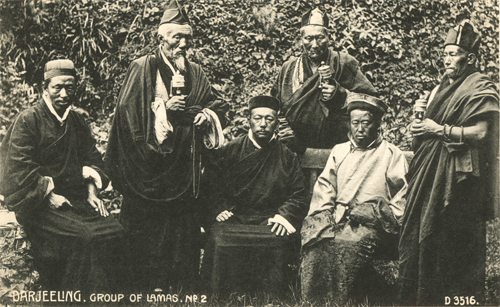 Fig. 6: Postcard of a staged photograph featuring the “Darjeeling lamas,” including Lama Sherab Gyatso (second from left), taken around 1890–1900. Courtesy of Emma Martin.
Fig. 6: Postcard of a staged photograph featuring the “Darjeeling lamas,” including Lama Sherab Gyatso (second from left), taken around 1890–1900. Courtesy of Emma Martin.As Waddell’s collecting practices show, monasteries in the borderlands were critical sites for access to different kinds of primary sources, but religion and scholarship were only part of a complex story unfolding in Darjeeling. In Ghum, lamas, officers and explorers blurred the lines between scholarly pursuits and information gathering for the purposes of colonial security.
Sherab Gyatso, the dictionary compiler for Das and the lama who worked with Waddell, was the Head lama of Ghum monastery, which still stands on the outskirts of Darjeeling (figure 6). He was Mongolian by birth, but served an astrologer to the eighth Panchen Lama, Lobsang Chökyi Wangchuk (1855–1882), at Tashi Lhunpo monastery. From the account Sherab Gyatso gave to Ugyen Gyatso, the lama left China in 1856, spending twelve years living as a prominent monastic figure in Kongbu, now Kongpo (Tibetan kong po) and then Pemakoichhen, now Pémakö (Tibetan pad ma bkhod) in south-eastern Tibet’s lower Tsangpo valley—a distance of more than 300 kilometres from Lhasa—before making his way to Darjeeling.[71] While not, strictly speaking, a pundit for the Survey of India, on arrival in Darjeeling he offered what he knew to Ugyen Gyatso, allowing the survey to make the first sketch map of the region in which he had lived. When Croft compiled his 1895 report on the progress of the dictionaries and translations currently in production at the Darjeeling press, he noted of Sherab Gyatso that “The Lama has hardly an equal in Tibetan scholarship on this side of the Himalayas; and as he is approaching eighty years of age, though still a man of remarkable energy, it is desirable to utilise his great erudition while it is still at our disposal.”[72] He continued his dual monastic and intelligence roles at Ghum, searching out illustrative passages of Tibetan text for Das’s dictionary project, while teaching at the Bhutia Boarding School.[73] After the construction of Ghum monastery, the British would send many notable future translators/cultural brokers to Ghum for Tibetan language training, including Laden La, the teacher and translator Lobzang Mingyur Dorje (n.d.), and the British India officer and interpreter Karma Sumdhon Paul (1877–c.1935).[74]
The lama’s scholarship also made Ghum monastery an important address for a number of international travellers. The Ukrainian Helena Blavatsky (1831–1891), a founding member of the Theosophical Society found refuge there during her stay in Darjeeling in 1882,[75] and the lama could also name amongst his pupils Ekai Kawaguchi (1846–1945),[76] the Japanese monk who came to Darjeeling in 1898 to prepare for his trip to Lhasa disguised as a Chinese pilgrim. Ekai Kawaguchi’s second Darjeeling-based tutor also found refuge with Sherab Gyatso at Ghum monastery. The considerable sum of sixty rupees given by the British India government to Ghum monastery for intelligence services rendered must in part have been warranted by the activities of the Buryat monk, Kachen Lobsang Tsering (also known as Sherab Gyatso, d.1909),[77] who was better known to the British as Shabdung Lama.[78] His life, like Palhese’s, was deeply affected by the clandestine mission of Das and Ugyen Gyatso.[79] Das had met Shabdung Lama in 1882 when he stayed in Drongtse, near Gyantse, during his 1881–1882 trip. He described him as a “boy-monk,” who “fetch[ed] water from the wells for my use.”[80] He was in fact the attendant of a revered Gelukpa (Tibetan dGe lugs pa) lama known to the British as Sengchen Lama, who also had ties to Tashi Lhunpo and Ghum monasteries.[81] Sengchen Lama met his end when the Tibetan government ordered his execution by drowning for giving Das a safe haven during his covert expedition. On his master’s execution in 1887, Shabdung Lama was force-marched to Lhasa and imprisoned there, but escaped, through Bhutan, to Darjeeling and finally to Ghum monastery.[82]
He was well established in Ghum by the early 1890s, working for Das as a clerk on his dictionary project in 1894 (perhaps as compensation). Despite Shabdung Lama’s participation in British India’s dictionary projects, the British, their colonial anxieties heightened, watched the activities of the lama’s guests at Ghum monastery with some interest. This is hardly surprising as they included several Russian “bogey men,” most significantly the Russian-trained Kalmykian explorer Ovshe Norzunov (n.d.) and later his monastic teacher, the Buryat lama Agvan Dorzhiev (1854–1938),[83] whom the British suspected of brokering diplomatic ties between the thirteenth Dalai Lama and Tsar Nicholas II.[84] Despite their suspicions, the British continued to employ Shabdung Lama as a Tibetan teacher, translator, and colonial intelligence gatherer. Captain (later Colonel) William Frederick Travers O’Connor (1870–1943), who wrote his own dictionary and who co-wrote government guidelines on Tibetan transliteration with Bell in 1904,[85] employed the lama not only as his Tibetan tutor, but also as an intelligence gatherer in the Darjeeling bazaar.[86] Bell was also likely to have been a pupil of Shabdung Lama, as he recalls that his first Tibetan teacher was “a gifted monk, who was born in Tibet and had worked for many years in a monastery not far from Gyangtse[sic].”[87]
The position of Ghum vividly illustrates the wider necessity for bringing those with pertinent information together in Darjeeling. The monastery was multi-faceted in its purpose and a perfect site for producing the entangled forms of colonial knowledge necessary to develop a comprehensive picture of Tibet. This monastic contact zone, built by a Mongolian and sponsored by the British, acted as a transitory home for a global community of spiritual seekers, monastic spies, and covert explorers. It also played a central role in training those who went on to become some of the most recognisable (if often hidden) names in early Tibetan Studies scholarship. Ghum, then, was a place where even perceived multiple allegiances—on occasion with Russia, one of British India’s most feared colonial opponents—were tolerated by British India officers.
Such a pivotal position made Sherab Gyatso and Shabdung Lama powerful, inasmuch as they were able to operate outside the authority of accepted colonial networks. This was not the case for most. Many of the men discussed here gained positions of power and in some cases significant wealth, but in tracing the processes of knowledge production it is clear that colonial barriers were often present. It is already obvious that British officers did not always acknowledge the men who made their publications possible, and there were considerable hurdles for those outside the core colonial networks. Despite this, there is an alternate reading of this transcultural encounter to be explored, as colonial officers did not always get exactly what they wanted, because access to valuable expertise was a matter of negotiation.
The boundaries of knowledgeI would add Sir Charles Bell should in due courtesy have mentioned in his books about the role I played specially when for that purpose he sent for me and sought my advice and help.
— David Macdonald[88]
Making a name was not always easy for the men who worked in Darjeeling and Kalimpong. Geographical boundaries placed limits on what was known and what was privileged, but there were other kinds of boundaries. The frustrated note written by Macdonald and quoted above can be read as articulating a much wider and long-suppressed disappointment in the value of knowledge production. As already noted, Bell and Hannah, amongst others, did to some extent acknowledge Macdonald, but Macdonald still felt it necessary to write himself back into the making of some of the most significant publications of the late nineteenth century (figure 7).
A man with whom Macdonald had good reason to be frustrated was Waddell, who failed to acknowledge that Macdonald spent close to a decade working with him on textual translations.
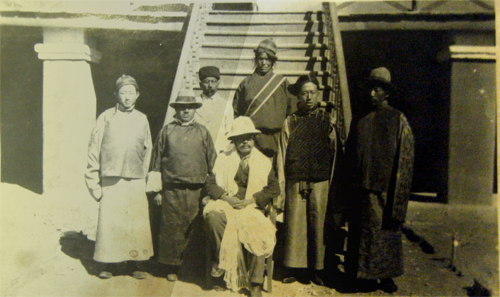 Fig. 7: David Macdonald (centre, seated) with Gyantse Trade Agency staff, 1921. Private collection.
Fig. 7: David Macdonald (centre, seated) with Gyantse Trade Agency staff, 1921. Private collection.When Macdonald left the Bhutia Boarding School at the age of nineteen, he received a posting at the Vaccination Department, on Waddell’s recommendation, spending most of his time at the Depot Headquarters in Ghum.[89] Only a few years older than his pupils, he filled his evenings by teaching English to several boys attending Sherab Gyatso’s Tibetan classes at Ghum monastery.[90] Yet the majority of his spare time was occupied with bringing some of Waddell’s best-known publications to fruition, including The Buddhism of Tibet and Waddell’s significant contribution to Risley’s The Sikhim Gazetteer. It is left to Macdonald to tell us that, “For some years I assisted this officer in the preparation of his works on the then little known religion of Tibet and Sikkim, Lamaism, and in some portions of his contribution to the Sikkim Gazetteer and the Linguistic Survey of India.”[91]
When surveying Macdonald’s standing within this scholarly network, one perhaps understands his career progression as an Anglo-Indian as exceptional. He did indeed break several employment barriers, securing appointments to posts previously given only to British officers, but he also had to push past boundaries that seem to have had the sole aim of excluding him from the recognition he deserved as a scholar and instructor. In 1924, now close to retirement, Macdonald was forced to take the Higher Proficiency Test in Tibetan by his new supervisor, Political Officer Frederick Marshman “Eric” Bailey (1882–1967) and his memoir does not hide his frustration over the incident.
I passed with ease, receiving a reward of two thousand rupees from Government. In a way, this test was a farce, for I had been appointed an examiner in the Degree of Honour test in that language as far back as 1906. This is a higher examination than that for which I was allowed to appear. However, the rules admitted of my appearing, and so I did.[92]
Those who set the rules and demanded his attendance also seemingly wished to put Macdonald in his “colonial” place. In 1921, Bailey took over the post of Political Officer not from his official predecessor, Bell, but from Macdonald, who had been acting in the role until Bailey’s arrival. McKay notes that Bailey “found it demeaning to his prestige to take over Sikkim from an Anglo-Sikkimese.”[93] Bailey, it seems, wanted to assert his authority over those whom he thought of as his imperial inferiors.
Macdonald was not the only man to suffer from being passed over in silence in the pages of Darjeeling-based scholarship—I have noted several others in this article. Kazi Dawa Samdup, with whom I began this article, also found complex and uneven hurdles as he pursued his philological activities.[94] Family pressures meant that Samdup became a British India employee rather than a monk, as he hoped, but he nevertheless became a Tibetan Buddhist teacher to Walter Yeeling Evan-Wentz (1878–1965), the American “author” of The Tibetan Book of the Dead, who could neither speak nor read Tibetan,[95] as well as to Hannah and the French explorer and scholar Alexandra David Neel (1868–1969).[96]
His expertise was called upon for several Anglo-Sikkimese projects, including the translating and annotation of the History of Sikkim,[97] a project undertaken at the behest of John Claude White (1953–1919), Bell’s predecessor as Political Officer. He also acted as chief translator for the British during White’s and the Sikkim delegation’s trip to Calcutta in 1905–1906 for the ninth Panchen Lama’s visit to the Viceroy of India, and under Bell’s tenure he acted as the Chögyal’s interpreter during the Delhi Durbar of 1911. He also played a critical role at the Simla convention of 1913–1914, translating many of the documents the Tibetans brought with them to establish their claim to independence.[98] He became a renowned scholar in his own right following the publication of his acclaimed An English-Tibetan Dictionary in 1919, which both Hannah and Macdonald had urged him to finish. In the same year, he moved to Calcutta University to take up a professorship in Tibetan.
Despite his seemingly smooth rise, it had been an eventful intellectual journey for Samdup. From the preface to his dictionary it is clear that his position as a local scholar, who began his work outside of approved colonial structures, limited his abilities to gather the necessary information. Samdup began compiling his dictionary in 1902 in Darjeeling, but despite the hill station’s philological heritage, until 1906
the only books of reference which I wished to consult—viz. (1) Csoma de Körös’s and (2) Jäschkes’ Tibetan-English Dictionaries, and that masterpiece of work, the late Rai Sarat Chandra Das Bahadur’s Tibetan-English Dictionary—were all beyond my means of purchase and could not be borrowed, and I often despaired of being able to complete my self-imposed task.[99]
Sponsorship, and specifically colonial sponsorship, was evidently critical here, and without it scholarship proved difficult to pursue. Following his move to Gangtok in 1905 as headmaster of the Bhutia Boarding school outpost, White became Samdup’s sponsor and only then did he receive the dictionaries he needed to complete his work. When White retired from service in 1908, Samdup faced new challenges. He assumed that his sponsor would continue to support his complex philological work, but when White retired he left his scholarly responsibilities behind. Samdup had to wait until a further opportunity presented itself in 1911 at the Delhi Durbar. There he met Denison Ross, who recommended his work to Sir Ashutosh Mukerjee, and as a result Samdup (and by extension his pupil, Hannah) found a new sponsor in the form of Calcutta University. Samdup came to the realisation that research and publishing one’s work was only possible if sanctioned and supported by a colonial infrastructure. However, I do not wish to present a picture of victimhood here, as Samdup, an established intellectual, was also more than willing and able to create barriers to his knowledge for the colonial officers he worked with.
When White retired in November 1908, he wrote to Samdup and noted of his successor that “I think you will like Mr Bell.”[100] Bell was now Political Officer for Sikkim, Bhutan, and Tibet, based at the Gangtok Residency, and Samdup was an established headmaster. The two men developed a scholarly relationship around 1912 that lasted until Bell’s retirement in 1918. They regularly spent their Saturday afternoons together discussing texts that Samdup translated for Bell. By 1916 Bell and Samdup had worked together on numerous translation projects, but it is all too clear that Bell was still wholly reliant on Samdup for his authoritative translation skills. In June, Bell sent Samdup a letter asking him to estimate the cost of a new translation: “[W]hat would [be] your charge for translating this History of Tibet by the 5th Dalai Lama (113 sheets)? A typed translation would be preferred. The translation should be [a] simple one, i.e. not ornate.”[101] It seems that their scholarly relationship was agreed on a “pay as you go” basis. Bell needed to buy his access to Tibetan culture, for even with unequal colonial power balances, Samdup’s knowledge was not available to him free of charge. Samdup was more than willing to drive a hard bargain, and after he named his price, which was beyond the means available, Bell wrote that he could not afford it, and offered changed terms.
Please return the History by the 5th Dalai Lama unless you are willing to reduce your terms. I’m sorry that I cannot afford your price. I can offer only two rupees per sheet, the dedication + poetry being omitted, + only the plain history part translated. I should of course provide the paper. The translation need not be typed. If these terms suit you, please keep the History + let me know, + I will send you the paper.[102]
Samdup knew that such a project needed a translator who thought in Tibetan. He knew the outer limits of this colonial officer’s scholarly abilities, and as a result he placed a solid value on his own scholarly worth. There are no further letters on how the negotiations were resolved, but obviously an agreement was reached on the new terms and the translations found their way into Bell’s Religion of Tibet, where Samdup is acknowledged in a chapter Bell called “Sources”.
Relevant portions of the leading histories so received have been translated for me by Mr Negi Amar Chand, Mr David Macdonald—who speaks and writes Tibetan more easily than English—and Rai Bahadur Nor-bu Dhon-dup. A great deal has been done by Mr Tse-ring Pün-tso and most of all by that tower of learning, the late Kazi Da-wa Sam-trup.[103]
Bell’s and Samdup’s experiences bring into sharp focus the lived realities of scholarly networks in colonial hill stations. One’s own expertise was controlled, haggled over, and promoted. Sponsors could open many doors, but many more opportunities could be lost if those who claimed to be knowledgeable omitted to mention with whom they had produced their publications. Knowledge production was not a genteel profession here in the hill stations of eastern India; it was a decidedly contentious process of negotiation under the complex asymmetrical conditions of colonialism.
ConclusionDarjeeling and Kalimpong were transcultural scholarly spaces that, by their very nature, were dynamic and continually reconfigured by local and colonial politics, by trade and by the highly mobile people that lived and worked there. Borderlands are often conceptualised as peripheries, delineating the boundaries of what is known about places and peoples beyond frontiers. But these hill stations on the boundaries figured as central hubs, with information flowing in from both sides of the border. Modern forms of knowledge production about Tibet developed here, especially in the realms of language and ethnography. Colonial scholars looked towards Darjeeling to find the best-informed and most accessible local intellectuals to help them establish themselves in contemporary Tibetan Studies. This is where they found people with the necessary language and cultural background, who had access to sources and areas in Tibet that were off limits. This notion of the Himalayan hill station as a peripheral site can be turned on its head in Darjeeling and Kalimpong. The scholars who worked here were at the centre of Tibet-related knowledge production, feeding those at the peripheries—the museums, libraries, and universities of Europe and North America—with new publications and specimens.
Approaching this knowledge production from a local Himalayan perspective shows the complexity of the scholarly, social, and political processes of information collection and publication. Local expertise was grappled with and negotiated in a way that gave considerable agency to select local intellectuals and never simply reproduced the asymmetry of colonial settings. Several genealogies came together here. Colonial genealogies anchored in successions to the same administrative position merged with lineages anchored in teacher-student relations and local family lineages to produce site-specific knowledge.
Colonial knowledge was then fundamentally informed by multiple ways of reading the Tibetan world. The final products of these encounters, the dictionaries, grammars, and manuals, with their partial acknowledgements of local contributors, represent a highly visible transcultural interaction while clearly retaining their distinctly colonial flair. These hybrid texts allow us to trace the scholarly discussions, ambitions, disappointments, and uncertainties that made new ways of reading Tibet possible in the hill stations of the Himalayas.
_______________
Notes:[1] Thomas Holdich, The Story of Exploration: Tibet, the Mysterious (London: Alston Rivers Ltd, 1906).
[2] Herodotus, The Histories (Oxford: Oxford University Press, 1998), 212–213.
[3] The British Mission to Tibet was sanctioned by then Viceroy Curzon and led by Colonel (later Sir) Francis Younghusband. Its initial aim was to sign a trade agreement with Tibet. However, the mission turned into a punitive expedition and many Tibetans were killed and monasteries and homes were looted. A unilateral agreement was signed in the Potala in Lhasa in September 1904 by a proxy head of state, as the Dalai Lama had fled to Mongolia.
[4] See
http://www.asia-europe.uni-heidelberg.d ... mpong.html [Accessed on 2. July 2016].
[5] Mary Louise Pratt, Imperial Eyes: Travel Writing and Transculturation, 2nd ed. (London: Routledge, 2008), 7.
[6] Ibid., 7.
[7] Afef Bennesaieh, ed., Amériques Transculutrelles / Transcultural Americas (Ottawa: University of Ottawa Press, 2010), 16.
[8] Henk Driessen, “Mediterranean Divides and Connections: The Role of Dragomans as Cultural Brokers,” in Agents of Transculturation, ed. Sebastian Jobs and Gesa Mackenthun (Münster: Waxmann, 2013), 30.
[9] Viceroy Curzon believed that Russian guns were stockpiled in Tibet and he was disturbed by accounts of Tibetan delegations to Russia. The Mission to Lhasa was conceived based on this intelligence. Sam Van Schaik, Tibet: A History (New Haven: Yale University Press, 2011), 171.
[10] Rama Sundari Mantena, The Origins of Modern Historiography in India (New York: Palgrave Macmillan, 2012), 151–177.
[11] Ibid., 54.
[12] Susie Rijnhart, With the Tibetans in Tent and Temple (Ohio: Foreign Christian Missionary Society, 1901).
[13] See Douglas A. Wissing, Pioneer in Tibet: The Life and Perils of Dr. Albert Shelton (New York: Palgrave Macmillan, 2004).
[14] W. Y. Evan-Wentz, The Tibetan Book of the Dead (1927; repr., London: Oxford University Press, 1957), 1xiii.
[15] Ananda K. Coomaraswamy, Hinduism and Buddhism (New York: Philosophical Library, 1943), 49.
[16] Evan-Wentz, The Tibetan Book of the Dead, 1xiii.
[17] Lama Kazi Dawasamdup, An English-Tibetan Dictionary (Calcutta: Baptist Mission Press, 1919), vi.
[18] Driessen, “Mediterranean Divides and Connections,” 30.
[19] For a discussion on the production of reliable legal knowledge, see Kapil Raj, Relocating Modern Science: Circulation and the Construction of Knowledge in South Asia and Europe, 1650–1900 (Basingstoke: Palgrave Macmillan, 2007), 95–138.
[20] Mantena, The Origins of Modern Historiography, 54.
[21] Herbert Bruce Hannah, Grammar of the Tibetan Language, Literary and Colloquial (Calcutta: Baptist Mission Press, 1912), iii. The Baptist (or Serampore) Mission Press played a significant role in the publication and global circulation of resources on the Tibetan language. See John Bray, “Missionaries, Officials and the Making of the Dictionary of Bhotanta, or Boutan language,” Zentralasiatische Studien 37 (2008): 33–75.
[22] Alexander Csoma de Kőrös, Essay towards a Dictionary, Tibetan and English, with the assistance of Bandé Sangs-rgyas Phuntshogs (Calcutta: Baptist Mission Press, 1834).
[23] His exact words were, “wherever he gropes there is something that seems ever to elude him; and amid the weird philological phantoms that flit uncertainly around in the prevailing gloom, his constant cry, I feel very sure, is still one for more light.” Hannah, Grammar of the Tibetan Language, iii.
[24] Hannah describes Samdup as “my Münshi,” a Persian word for interpreter or secretary. Hannah, Grammar of the Tibetan Language, x.
[25] Dawasamdup, An English-Tibetan Dictionary, vii.
[26] Denison Ross also catalogued the collection of the Hungarian explorer M. Aurel Stein at the British Museum. See Imre Galambos, “Touched a Nation’s Heart: Sir E. Denison Ross and Alexander Csoma de Körös,” Journal of the Royal Asiatic Society 21, no. 3 (2011): 361–375.
[27] Hannah, Grammar of the Tibetan Language, x.
[28] Thomas Herbert Lewin, A Manual of Tibetan, being a Guide to the colloquial Speech of Tibet, in a Series of Progressive Exercises, Prepared with the Assistance of Yapa Uygen Gyastho, a Learned Lama of the Monastery of Pemiongchi (Calcutta: Baptist Mission Press, 1879).
[29] Nicholas Rhodes and Deki Rhodes, A Man of the Frontier: S. W. Laden La (Kolkata: Mira Bose, 2006), 8. For further details on the wealth and status he would accrue later in life, see Peter Richardus, ed., Tibetan Lives: Three Himalayan Autobiographies (Richmond: Curzon, 1998), 25–26.
[30] For the recruitment, training, and expeditions undertaken by these men see, Derek J. Waller, The Pundits: British Exploration of Tibet and Central Asia (Lexington: University Press of Kentucky, 2004).
[31] See Sarat Chandra Das, Journal to Lhasa and Central Tibet (London: John Murray, 1902), vii. See also page xi for Das’s short biographical account of Ugyen Gyatso.
[32] Sven Hedin, Scientific Results of a Journey in Central Asia, 1899–1902 (Stockholm: Lithographic Institute of the General Staff of the Swedish Army, 1907), 4:526.
[33] The wider significance of what was happening in Darjeeling is clear from the circulation of the supposedly confidential reports produced by Das. Waller notes that they “were actually to be purchased in the open market in St. Petersburg soon after it was [they were] printed.” See Waller, The Pundits, 293n40.
[34] Das had met Rockhill in 1885 in Peking, when he accompanied the British diplomat Colman Macaulay to China. Macaulay’s visit failed to secure permission from the Qing Empire for a political and scientific mission to Tibet. Sarat Chandra Das, Autobiography: Narrative of the Incidents of My Early Life (Calcutta: Past & Present, 1969), v.
[35] Sarat Chandra Das, A Tibetan-English Dictionary with Sanskrit Synonyms (Calcutta: Bengal Secretariat Book Depot, 1902), i. Scholarship was often described in terms of exploration by the authors of these early works.
[36] Das, A Tibetan-English Dictionary, iii.
[37] See, F. W. Thomas, “Sandberg, Samuel Louis Graham (1851–1905),” rev. Schuyler Jones, in Oxford Dictionary of National Biography (Oxford: Oxford University Press, 2004),
http://www.oxforddnb.com/view/article/35932 [Accessed on 2. November 2013].
[38] Bray, “A History of the Moravian Church in India,” in The Himalayan Mission: Moravian Church Centenary, Leh, Ladakh, India, 1885–1985, ed. Moravian Church (Leh: Moravian Church, 1985), 27–75 and J. E. Hutton, A History of Moravian Missions (London: Moravian Publication Office, 1922), 861. The revisors’ preface written by Sandberg and Heyde and included at the beginning of the dictionary, suggests that the project suffered from immense difficulties and that Sandberg’s and Heyde’s revisions were considerable. Das, A Tibetan-English Dictionary, xi–xvi.
[39] Many thanks to Amy Holmes-Tagchungdarpa for pointing out Acharya’s colonial connections. Having learnt the Tibetan language in Darjeeling, he became a translator for the British, most notably during the ninth Panchen Lama’s visit to Calcutta in 1905. See Satish Chandra Vidyabhusana, A History of Indian Logic (Calcutta: University of Calcutta, 1921), xviii.
[40] Lopez Jr., citing Tibetologist Dan Martin, points out that “It was Sherab Gyatso who was the true author of Sarat Chandra Das’s Tibetan-English Dictionary, a fact only acknowledged on the Tibetan title page of this work.” See Donald S. Lopez Jr., “The Tibetan Book of the Dead:” A Biography (New Jersey: Princeton University Press, 2011), 159n4.
[41] A second uncle of Laden La’s was also a pundit. Rinzin Namgyal (RN) made covert explorations in Sikkim and Tibet, leading the 1884–1885 survey team that completed the first tour around Kangchenjunga in Sikkim. See Indra Singh Rawat, Indian Explorers of the Nineteenth Century (New Delhi: Ministry of Information, 1973), xviii.
[42] See, Alex McKay, Tibet and the British Raj (Richmond: Curzon Press, 1997), 111; Nicholas Rhodes and Deki Rhodes, “Sonam Wangfel Laden La—Tibet 1924 and 1930,” The Tibet Journal 28, no. 4 (Winter 2003): 77–90.
[43] “Type copy of book VI,” Eur Mss F80/218, Ch. 1, 2, India Office Records (hereafter IOR), British Library.
[44] Rhodes and Rhodes, A Man of the Frontier, 17.
[45] David Macdonald, Twenty Years in Tibet (1932; repr., Varanasi: Pilgrim Publishing, 2005), 40.
[46] Charles Alfred Bell, Manual of Colloquial Tibetan (Calcutta: Baptist Mission Press, 1905).
[47] I am grateful to Mr Tashi Tsering, Director of Amnye Machen Institute, Dharamshala, who shared his rare copy of this dictionary with me.
[48] For a brief biographical account, see Luciano Petech, Aristocracy and Government of Tibet (Rome: Instituto Italiano Per Il Medio Ed Estremo Oriente, 1973), 224. Gungthang’s work on the thirteenth Dalai Lama was a mandatory text for the high proficiency exam in Tibetan taken by colonial officers. Sarat Chandra Das, An Introduction to the Grammar of the Tibetan Language (1915; repr., Delhi: Motilal Banarsidass, 1972), ii.
[49] L. Austine Waddell, The Buddhism of Tibet; or, Lamaism, 2nd ed. (Cambridge: W. Heffer & Sons Ltd, 1939), viii.
[50] Ibid., xii.
[51] Ibid., x.
[52] Ibid., xii
[53] See Clare E. Harris, Museum on the Roof of the World, (Chicago: University of Chicago Press, 2012), 38–47 for discussions on Waddell and museological networks in the late nineteenth century.
[54] Waddell would also cite Das’s still supposedly confidential reports as a source for his own work.
[55] Waddell, The Buddhism of Tibet, vii. It seems that Schlagintweit’s brothers did have Tibetan connections. See Moritz von Brescius, “Empires of Opportunities: The Role of German Travelling Scholars in Europe’s Overseas Empires, ca. 1830–1880,” (PhD thesis, European University Institute/Cambridge University, 2015).
[56] L. Austine Waddell, The Buddhism of Tibet, or Lamaism: with its mystic cults, symbolism and mythology, and in its relation to Indian Buddhism, (London: W. H. Allen & Co., 1895), xi.
[57] Ibid., xii.
[58] This interesting example of a cultural broker (Achuk Tsering, see next section) dismissing the work of a rival also identifies Waddell’s Tibetan lama. “R[ai] B[ahadur] Achuk Tshering [sic] tells me that Col. Waddell’s lama (who worked with him for a long time + told Achuk Tshering [sic] that he, Col. Waddell was compiling a book), was not very learned. His name was Lama Pema Chöphel + he was Tibetan teacher at the Bhutia Boarding School at Darjeeling. He did not know much Tibetan literature.” Charles Alfred Bell, Diary Volume VI, February 23, 1918, private collection.
[59] Charles Alfred Bell, Portrait of a Dalai Lama: The Life and Times of the Great Thirteenth (1946; repr., London: Wisdom Publications, 1987), 263.
[60] Charles Alfred Bell, Settlement Officer, final report on the survey and settlement of the Kalimpong government estate in the district of Darjeeling 1901–1903 [published 1905], Eur Mss F80/239, Rs 5 7s. 6.d, IOR, British Library. Ugyen Gyatso was now the estate’s manager.
[61] An 1888 campaign medal, still with the family in Kalimpong, provides this thread of evidence. I am indebted to Achuk Tsering’s family for our discussions.
[62] Bell, Portrait of a Dalai Lama, 245.
[63] Thanks to Mr Tashi Densapa for this information. Tashi Tsering, personal communication with the author, April 10, 2013.
[64] Charles Alfred Bell, Tibet Notebook II, 91, private collection.
[65] Bell, Portrait of a Dalai Lama, 25.
[66] Ibid., 25.
[67] McKay, Tibet and the British Raj, 124.
[68] Darjeeling Confidential Frontier Reports, November 1903, nos. 40–80, Secret External, Foreign Department, National Archives of India, Delhi.
[69] Charles Alfred Bell, Religion of Tibet (1931; repr., New Delhi: Motilal Banarsidass Publishers, 2000), 49.
[70] E. C. Dozey, A Concise History of the Darjeeling District since 1835, 3rd ed. (Darjeeling: Gurkha Press, 1922), 80.
[71] G. Strahan, report on the explorations of Lama Sherap Gyatsho, 1856–68, explorer K-P, 1880–84, Lama UG [This is Ugyen Gyatso.] 1883, explorer RN 1885–86, explorer PA 1885–86, in Sikkim, Bhutan and Tibet, 1889, Dehra Dun, V/27/69/26, IOR, British Library. In Darjeeling Sherab Gyatso posed as a Tibetan lama in a series of staged photographs commissioned and used by Das and Waddell. See Harris, Museum on the Roof of the World, 89–103.
[72] G. Strahan, report on the explorations of […], V/27/69/26, IOR.
[73] Das, Autobiography, 31.
[74] See Richardus, ed., Tibetan Lives, 79, for a vignette of Sherab Gyatso’s teaching practice, provided by Karma Sumdhon Paul. All three would work for Das, but would go unacknowledged.
[75] Das would also provide her with texts for her writings. See K. Paul Johnson, Initiates of Theosophical Masters (Albany: State University of New York Press, 1995), 24–25.
[76] On Das’s recommendation, see Ekai Kawaguchi, Three Years in Tibet (Benares: Theosophical Printing Press, 1909), 11. Das died in 1917, shortly after travelling with Kawaguchi to Japan to study Buddhism. See Das, Autobiography, vi.
[77] See sle zur ‘jigs med dbang phyug et al. Bod kyi rig gnas lo rgyus dpyad gzhi’i rgyu cha bdams bsgrigs, ‘don thengs bdun pa (Lhasa: bod rang skyong ljongs par ‘debs bzo grwa nas par lha sa, 1985), 7:9–11.
[78] The biographies of the Mongolian Sherab Gyatso and the Buryat Shabdung Lama have been conflated to create one man by Harris, Lopez Jr., and Toni Huber. Harris, Museum on the Roof of the World; Toni Huber, The Holy Land Reborn: Pilgrimage and the Tibetan Reinvention of Buddhist India (Chicago: University of Chicago Press, 2008), Donald S. Lopez Jr., Prisoners of Shangri-la: Tibetan Buddhism and the West (Chicago: University of Chicago Press, 1999). I align myself with McKay, because sources, some cited here for the first time, clearly refer to two separate men. McKay, "The Drowning of Lama Sengchen Kyabying: A Preliminary Enquiry from British Sources," in Proceedings of the Ninth Seminar of the IATS, 2000, vol. 1, Tibet: Past and Present, Tibetan Studies 1, ed. Henk Blezer (Leiden: Brill, 2002), 263-280.
[79] See McKay, “The Drowning of Lama Sengchen Kyabying.”
[80] Das, Autobiography, 60.
[81] The Phalha family were in a “priest-patron” relationship with the Sengchen Lama.
[82] ‘jigs med dbang phyug, Bod kyi rig gnas lo rgyus […], 10.
[83] For detailed accounts of Dorzhiev’s life see John Snelling, The Story of Agvan Dorzhiev, Lhasa’s Emissary to the Tzar (Shaftsbury: Element Books Ltd, 1993) and Alexandre Andreyev, Soviet Russia and Tibet: The Debacle of Secret Diplomacy, 1918–1930s (Leiden: Brill, 2003).
[84] In 1901, Laden La would inform Walsh about these uninvited visitors and Norzunov would be placed under surveillance and interviewed on several occasions. See Snelling, The Story of Agvan Dorzhiev, 67–68. They were right to suspect him, see Jampa Samten and Nikolay Tsyrempilov, From Tibet Confidentially (Dharamshala: Library of Tibetan Works & Archives, 2012).
[85] Charles Alfred Bell and Frederick O’Connor, Rules for the Phonetic Transcription into English of Tibetan Words (Darjeeling, 1904).
[86] McKay, “The Drowning of Lama Sengchen Kyabying,” 270.
[87] Bell, Portrait of a Dalai Lama, 24.
[88] David Macdonald, untitled and undated note on the subject of China and Tibet, 1921, private collection.
[89] Macdonald, Twenty Years in Tibet, 12.
[90] Richardus, Tibetan Lives, 80.
[91] Macdonald, Twenty Years in Tibet, 12.
[92] Macdonald, Twenty Years in Tibet, 311.
[93] McKay, Tibet and the British Raj, 103.
[94] Kazi Dawa Samdup’s name appeared in the acknowledgements of several publications, but he was not necessarily given the substantial credit he deserved. See Ken Winkler, Pilgrim of Clear Light: The Biography of Dr. Walter Evan Wentz (1982; repr., Bangkok: BooksMango, 2013); Kathleen Taylor, Sir John Woodroffe, Tantra, and Bengal (2001; repr., Abingdon: Routledge, 2013).
[95] See, Dasho P. W. Samdup, “A Brief Biography of Kazi Dawa Samdup (1868–1922),” Bulletin of Tibetology 44, nos. 1–2 (2008): 155–158. Laden La recommended Samdup to Evan-Wentz in 1919 when the two met in Darjeeling. Laden La also worked on translations for Evan-Wentz’s The Tibetan Book of the Great Liberation, finally published in 1954.
[96] David-Neel travelled in disguise overland from China to Lhasa in 1924. Her inspiration came during a meeting in 1917 in Japan, with Ekai Kawaguchi. See Samuel Thévoz, “On the Threshold of the ‘Land of Marvels:’ Alexandra David-Neel in Sikkim and the Making of Global Buddhism,” Transcultural Studies 1 (2016): 168.
[97] See Tashi Tsering, “A Short Communication about the 1908 ‘Bras ljongs rgyal rabs,’ Bulletin of Tibetology 48, no. 1 (2012): 33–60.
[98] Ryosuke Kobayashi, “An Analytical Study of the Tibetan Record of the Simla Conference, 1913–1914: Shing stag rgya gar ‘phags pa’i yul du dbyin bod rgya gsum chings mol mdzad lugs kun gsal me long,” in Current Issues and Progress in Tibetan Studies: Proceedings of the Third International Seminar of Young Tibetologists, ed. Tsughito Takeuchi et al. (Kobe: University of Foreign Studies, 2013), 183–200.
[99] Dawasamdup, An English-Tibetan Dictionary, 2.
[100] White to Samdup, 1 November 1908. Kazi Dawa Samdup papers, L/PS/10/C909, IOR, British Library.
[101] Bell to Samdup, 30 June 1916, Kazi Dawa Samdup papers, L/PS/10/C909.
[102] Bell to Samdup, 7 July 1916, Kazi Dawa Samdup papers, L/PS/10/C909.
[103] Bell, Religion of Tibet, 199–200.
